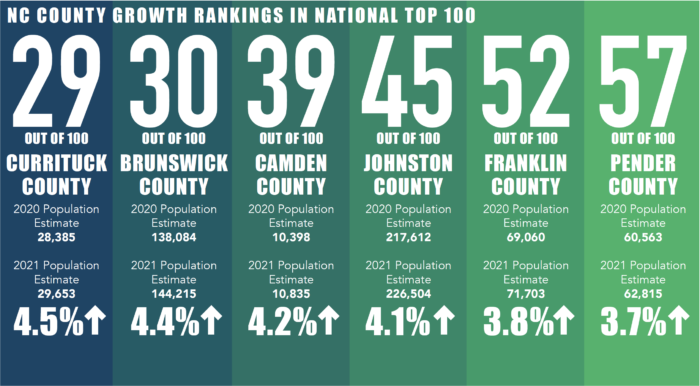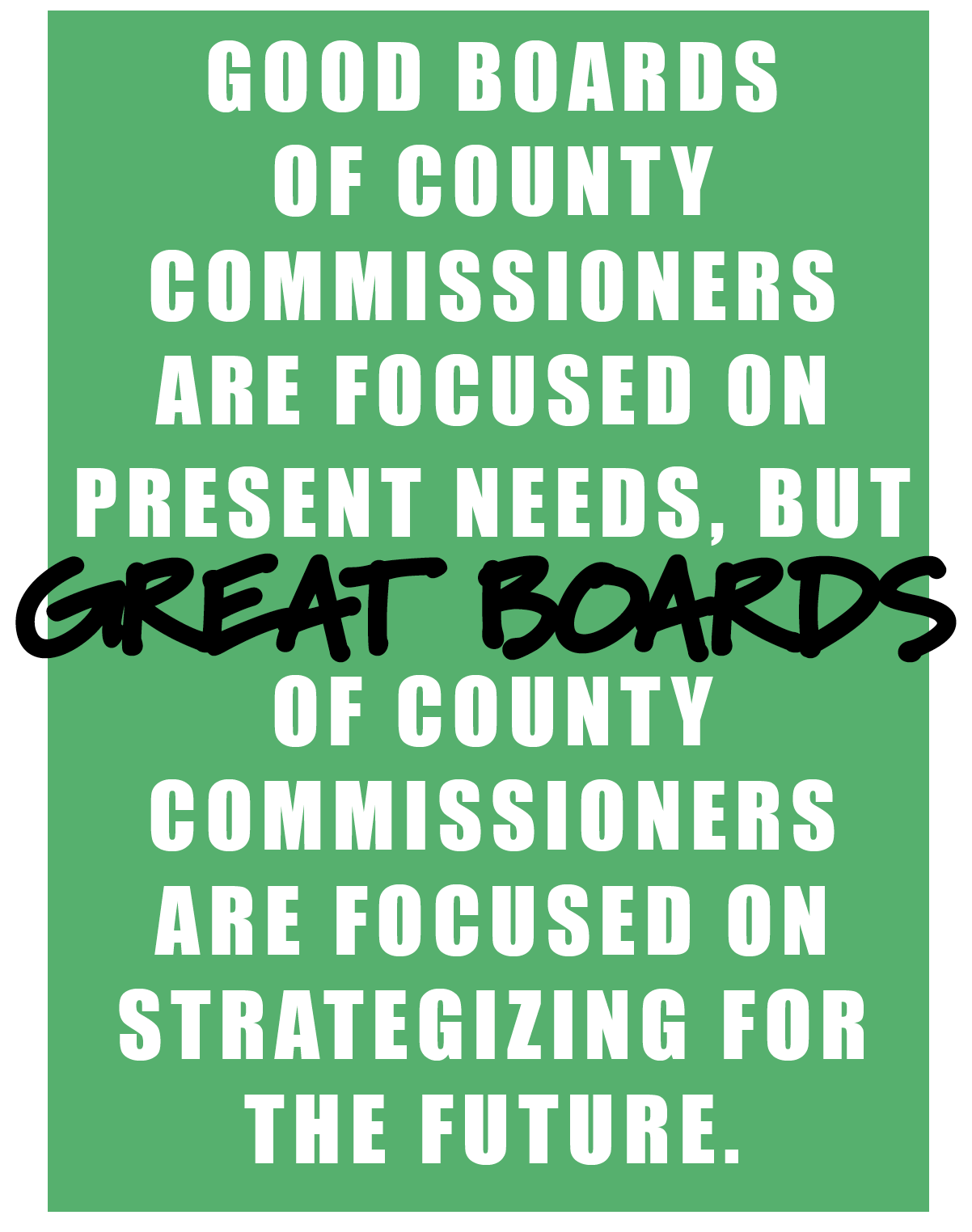
County Population Increases Reflected in Budget Priorities
by Carl Wilkins | NCACC Strategic Communications Specialist
The secret is out; North Carolina is one of the best places to live. According to US News & World Report, North Carolina has consistently risen in the ranks and is currently the 13th best state to live in America due to its excellent quality of living and services. North Carolina’s well-deserved accolades have translated into consistent and rapid population growth in some areas.
However, North Carolina’s growth is uneven throughout the state. In 2021, North Carolina had six of the top 100 fastest growing counties in the nation: Brunswick, Johnston, Franklin, Camden, Pender, and Currituck County.
Growth is great, but it has challenges. Like a child quickly growing out of their clothes, counties are living entities that require constant care. As a branch of government heavily responsible for North Carolina’s outstanding quality of life and services, the counties provide many of the services that enrich North Carolina’s quality of living. Counties have been critical to residents since America’s inception and were created to give citizens greater access to government services. All counties are different; however, they all enhance the lives of residents by providing services across the board, such as: public health, public education, libraries, law enforcement, and social services. Counties offer these essential services for residents using funding from several sources, but taxes provide most revenue.

Property tax is the largest revenue source for county governments, and it’s levied on four property types: real, personal, motor vehicle, and public service companies. North Carolina has one of the best property tax systems in the country supported by well-written laws and well-developed business practices, according to David Baker, NCACC Director of Tax and Revenue Outreach.
“Good business practices lead to more fair and equitable appraisals for taxpayers and higher collections rates, providing more money to fund county programs and services. There are 20 counties that currently utilize the NC Property Tax Solution (NCPTS), an innovative property tax program owned and licensed to counties by the NCACC,”
said Baker. “It was developed in partnership with a North Carolina-based software provider, Farragut – which helps counties manage property tax records and billing. What distinguishes NCPTS is its county-led collaborative process. Member counties guide the development of the entire system and direct the work of the software developer.”
The NCPTS streamlines and optimizes all aspects of the property tax process for counties. NCPTS members achieve collections rates 1-2% higher than those counties that do
not use it, which translates to millions of dollars in revenue.
Counties are most effective when they maximize property tax collection which positively affects the budget and the county’s ability to deliver services. In terms of outlining and prioritizing the services a county will provide, the budget is one of the most important aspects of county government.
NCACC Outreach Associate and former Harnett County Manager Neil Emory states that, “the county budget is the financial roadmap that provides funding for resident services and investment in the community’s future. It’s the vision of the county commissioners and allocates funds to address the county’s current service delivery needs, while also addressing growth and capital needs. The budget tells you about the current needs of a county as well as future trends and investments.”
All counties are different; thus, all county budgets are different. North Carolina’s most populous counties, such as Wake and Mecklenburg, are famously drawing newcomers,
but their growth rates do not measure up to the fastest growing counties, such as Brunswick and Currituck which are moving at breakneck speeds to keep up with their rapid growth.
Currituck and Brunswick Counties are ranked first and second in North Carolina population growth, indicating that people are moving to these counties in droves. The reasons are evident due to their beautiful beaches and tight-knit communities, but a 4.5% gain or an extra 6,000 people in one year can change the dynamic.
Unprecedented growth strains the counties’ ability to provide services for residents and shows stress fractures where attention is needed. For example, due to COVID and the “Great Resignation,” staffing shortages are rampant nationwide. Like Fortune 500 companies, counties are large employers also struggling to keep up with staff to support their new residents’ needs.
“It’s always challenging for us to pull in people with technical experiences like law enforcement and paramedics, so much so that our largest fiscal year 2021-2022 budget priority is employee retention, recruitment, and succession planning,” said Brunswick County Commission Chair Randy Thompson. “We just completed a countywide compensation study, and from that, we substantially increased many of our county’s positions’ salaries. Since doing that, we have already noticed that we have a larger pool of employees and applicants. We hope to continue doing these compensation studies to stay in line with the growth of our state.”

Good boards of county commissioners are focused on present needs, but great boards of county commissioners are focused on strategizing for the future.
“Growth comes with increased revenue and tax base, but at the same time, it comes with costs like additional people served and services, so counties need to be thinking
long term,” added Emory. “A big part of the boards of commissioners’ duty is to think about how big we plan to be in 20 years, so we are not behind.”
When an additional 6,000 people are added to a county’s water infrastructure system in a year, it’s too late to expand when the pipes are bursting. That’s why proactive planning is crucial, and counties refer to this process of developing good budgeting decisions 5-20 years out for large projects and purchases as the capital improvement plan (CIP). Typically, these CIP projects are related to infrastructure expansion. For example, Brunswick County’s FY 2021-2022 CIP includes constructing a transfer station at the existing landfill location and park renovations. These CIP projects require millions of dollars in county investment and are usually funded using a “pay as you go” method in Brunswick County to ensure fiscal responsibility.
COVID disturbed and prolonged counties’ capital improvement plans, but it provided additional opportunities to accomplish their goals faster for some.
“COVID has certainly provided challenges across the board but the additional federal funding such as the American Rescue Plan Act has allowed our county to make expenditures to support community access in numerous areas such as continued program expansion,” said Brunswick Board Chair Thompson.
So, the secret is out; North Carolina is one of the best places to live in America largely because of the great work of counties. A handful of counties acutely feel the impact of North Carolina’s rapid growth, and are using their budgets to allocate funds where residents’ needs are most dire. This is not the case in all counties, of course, and for others there are challenges other than accelerating population that dictate priorities in the budget. Regardless, North Carolina residents can rest easy knowing their county’s board of
commissioners are proactively planning the state’s future one budget at a time to keep our excellent quality of living and services.
